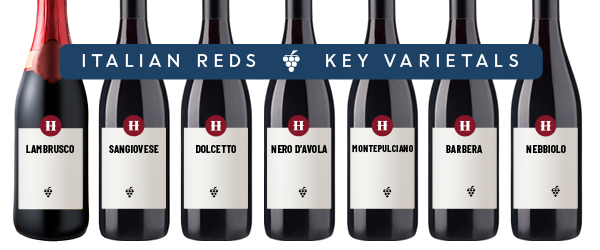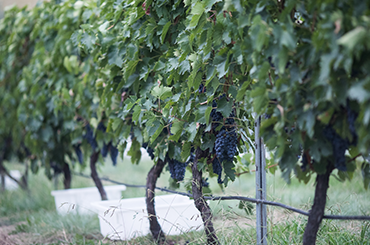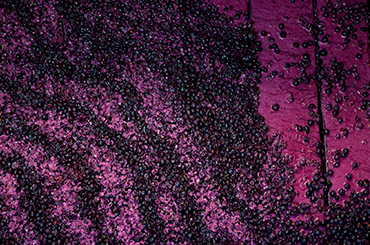- Piedmont: nebbiolo, barbera and dolcetto
- Tuscany: sangiovese and its ‘Super Tuscan’ blends
- Abruzzo: Montepulciano, a fuller bodied red that’s had some success in Australia
- Umbria: lush sagrantino wines
- Campania: aglianico, a bold red with firm tannins
- Veneto: complex red blends
- Emilia-Romagna: lambrusco to take seriously
- Sardinia: cannonau, aka grenache
- Sicily: nero d’Avola, suitable for growing in many regions Down Under
-
WHAT’S TO LOVE ABOUT ITALIAN REDS?
-
ITALIAN RED VARIETIES IN AUSTRALIA
-
SANGIOVESE
-
LAMBRUSCO
-
DOLCETTO
-
NERO d’AVOLA
-
MONTEPULCIANO
-
BARBERA
-
NEBBIOLO
-
WHERE IN AUSTRALIA ARE ITALIAN RED VARIETIES?
-
McLAREN VALE, SOUTH AUSTRALIA
-
KING VALLEY, VICTORIA
-
RIVERLAND, SOUTH AUSTRALIA
-
GRANITE BELT, QUEENSLAND
-
PAIRING ITALIAN REDS WITH FOOD
Italy is the largest producer of wine in the world. There is an array of varieties and styles across the Italian boot, but its reds are some of the greatest on the globe – from the ageworthy nebbiolo of Barolo to the pizza-friendly sangiovese of Tuscany.
Jump to section: Italian reds cheat sheet | What’s to love about Italian reds? | The Italian red varieties in Australia | Where in Australia are Italian red varieties? | Pairing Italian reds with food
In the north of Italy, the major players are nebbiolo, barbera and dolcetto, while the south is all about warmer climate styles such as aglianico and nero d’Avola. In the centre, you’ll find trattoria-perfect sangiovese and Montepulciano wines.
Two of the most important regions are Piedmont, home to the highly collectable nebbiolo of Barolo and Barbaresco, and Tuscany, famous for its top-tier sangiovese and ‘Super Tuscan’ wines (combining sangiovese with imports such as cabernet sauvignon and merlot).
It’s worth looking further afield, however, to find even more flavourful Italian reds. Many would be familiar with those sweet, cheap lambrusco wines, but Emilia-Romagna makes styles to take seriously, and you can find quite a few that are dry or off-dry. Umbria is known for its lush sagrantino, and Abruzzo is home to Montepulciano, a fuller bodied red that’s had some success in Australia. The nero d’Avola of Sicily is another that has taken off here for its ability to thrive in hot climates (and rich, fruity flavour profile comparable to shiraz). The island of Sardinia is a go-to for cannonau, the local name for grenache. Aglianico is a big, bold red with firm tannins, and its hero region is Campania in the south. For concentrated, long-lived red blends, look to Veneto.
Here’s an Italian reds cheat sheet:
… to name just a few.
Italian red wines tend to be a bit more savoury, with the structure to stand up to food. Tart acidity, supple tannins, rich fruit, and floral, earthy and herbal characters are some of the calling cards. Many Italian varieties are also hearty enough to thrive in dry conditions, providing a sustainable option to wine regions where water is in short supply.

The plantings of Italian red varieties in Australia are relatively few, but with many of these so-called ‘other’ reds being viticulturally well suited to our wine regions, the number is only going to grow. Italian reds fall under a broader category of less-common grapes that makes up just 11 per cent of the total plantings in this country, according to industry body Wine Australia, with shiraz, cabernet sauvignon, chardonnay and merlot dominating more than 50 per cent of vineyards. Of these, sangiovese is the most-planted Italian red in Australia (and also the most planted in Italy). See the other top Italian reds below, in order of biggest to smallest plantings.
This medium- to full-bodied, red-fruited, high acid, high tannin and savoury red wine comes in styles ranging from bright to bold. Sangiovese favours a warm, dry climate, but much like in Italy, it is grown in a variety of places around Australia, from the Riverland of South Australia to the High Country of Victoria and Canberra District of New South Wales.
Light-bodied and juicy, with red fruit and sweet spice, lambrusco is made in dry, off-dry and sweet styles. However, it’s those syrupy, bargain-basement types that are likely to be the most recognisable. That kind is still around, but there is also lambrusco in local vineyards intended for drier, more refined wines. Chalmers in Heathcote is a leader with its sparkling red made from lambrusco maestri, one of the 14 varieties used in Emilia-Romagna.
Rich and black-fruited, with low acid and moderate tannins, chocolate and floral notes, dolcetto is a dangerously drinkable Italian red wine. That accounts for the name, which roughly translates to ‘little sweet one’. This variety prefers a milder climate – Best’s Great Western makes one of the top examples locally.
Medium-bodied and fruit-forward, with floral and herbal notes, nero d’Avola is often compared to shiraz or cabernet sauvignon. That perhaps explains its uptake in Australia, offering a palate that’s approachable for local drinkers. It likes a warm climate, similar to that of its native Sicily, and you’ll find many wines from South Australia.
This generous variety, full of plush red, purple and black fruits, and often with a bold, spicy tannin structure, has been well received in Australia. It’s not a particularly fussy variety in the vineyard, and it flourishes everywhere from the cooler Adelaide Hills to the warmer Barossa Valley.
This cooler climate Italian red is medium-bodied (or lighter) with fine tannins, and typically features cherry and berry fruit, warm spice, lively acidity and herbal characters. While its heartland of Piedmont is cool, and regions that share this trait tend to produce some of the more complex styles, it can also perform in moderate to warm areas.
Light in colour, but big in flavour, with an ideal structure for ageing, nebbiolo ranges from ethereal, cherry-fruit styles to bold and tannic types. There’s a growing interest in nebbiolo in Australia, providing a fascination for winemakers similar to pinot noir. Also like pinot, nebbiolo is a challenge to grow, requiring a long time on the vine to ripen. It does better in cool, but not too cool, areas.
These are the core Italian red varieties in Australia right now, but some adventurous producers are playing around with others, including sagrantino, aglianico and more.
The Mediterranean climate of McLaren Vale, which enjoys the cooling influence of the ocean, is often compared to that of Italy. That’s one reason Italian reds have spread here, and another is migration, which has made its mark on the food and wine and encouraged the expansion of styles. The incredible soil diversity in this South Australian region is also favourable to diverse wine styles, and that’s proven by the immense number of varieties in the ground.
This High Country wine region has been strongly influenced by Italian migrants, who started with tobacco farms but soon saw a more lucrative opportunity in vines. This community also contributed their much-loved cuisine and so, of course, needed wine to match. That resulted in the King Valley as we know it today, which is often referred to as the ‘Little Italy’ of Victoria. It is particularly popular for its prosecco trail, but there are lots of Italian wine varieties here, including reds.
Inland regions reliant on irrigation water, such as the Riverland and Riverina, have been feeling the pinch of the warming climate. Producers like Ashley Ratcliff of Ricca Terra have been vocal advocates for replacing French varieties that are unsuitable for this environment with more vigorous types that require less water – such as Italian reds. Nero d’Avola, aglianico, barbera, lambrusco, Montepulciano, negroamaro and nero d’Troia are among the Italian grapes Ashley is growing.
This high-altitude region is championing an exotic mix of varieties via its Strangebird Alternative Wine Trail, among them many Italian types. Cooler climate Italian reds such as nebbiolo and barbera, and sturdier ones like sangiovese, are some of the front runners.
These are some of the regions focusing on Italian reds in Australia, but they can be found around the country. It would be remiss to talk about Italian wine in Australia without mentioning Chalmers in Heathcote, for example, as the family business has been one of the biggest importers and distributors of new clones and varieties here over several decades.
Red-sauce pizza and pasta dishes are perfect for pairing with savoury Italian reds like sangiovese and barbera. More opulent styles such as Montepulciano go great with meatballs, sausages, and hard cheeses. In general, Italian reds are known for their food-friendliness, so play around at the table and you’re bound to come up with some killer matches.









